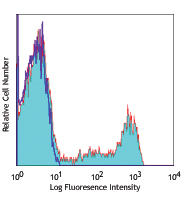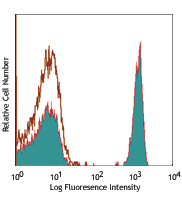- Clone
- OKT4 (See other available formats)
- Regulatory Status
- RUO
- Workshop
- HCDM listed
- Other Names
- T4
- Isotype
- Mouse IgG2b, κ
- Ave. Rating
- Submit a Review
- Product Citations
- publications

-

Human peripheral blood lymphocytes stained with OKT4 PE -

Human peripheral blood was stained with CD4 (clone OKT4) PE (solid line) or mouse IgG2b, κ PE isotype control (dashed line).
Data was acquired on the Moxi Flow, exported, and processed using FlowJo software.
| Cat # | Size | Price | Quantity Check Availability | Save | ||
|---|---|---|---|---|---|---|
| 317409 | 25 tests | 23€ | ||||
| 317410 | 100 tests | 53€ | ||||
CD4, also known as T4, is a 55 kD single-chain type I transmembrane glycoprotein expressed on most thymocytes, a subset of T cells, and monocytes/macrophages. CD4, a member of the Ig superfamily, recognizes antigens associated with MHC class II molecules and participates in cell-cell interactions, thymic differentiation, and signal transduction. CD4 acts as a primary receptor for HIV, binding to HIV gp120. CD4 has also been shown to interact with IL-16.
Product DetailsProduct Details
- Reactivity
- Human,Cynomolgus,Rhesus
- Antibody Type
- Monoclonal
- Host Species
- Mouse
- Immunogen
- Human peripheral T cells
- Formulation
- Phosphate-buffered solution, pH 7.2, containing 0.09% sodium azide and BSA (origin USA)
- Preparation
- The antibody was purified by affinity chromatography, and conjugated with PE under optimal conditions.
- Concentration
- Lot-specific (to obtain lot-specific concentration and expiration, please enter the lot number in our Certificate of Analysis online tool.)
- Storage & Handling
- The antibody solution should be stored undiluted between 2°C and 8°C, and protected from prolonged exposure to light. Do not freeze.
- Application
-
FC - Quality tested
- Recommended Usage
-
Each lot of this antibody is quality control tested by immunofluorescent staining with flow cytometric analysis. For flow cytometric staining, the suggested use of this reagent is 5 µl per million cells in 100 µl staining volume or 5 µl per 100 µl of whole blood.
- Excitation Laser
-
Blue Laser (488 nm)
Green Laser (532 nm)/Yellow-Green Laser (561 nm)
- Application Notes
-
The OKT4 antibody binds to the D3 domain of CD4 and does not block HIV binding. Additional reported applications (for the relevant formats) include: immunohistochemistry of frozen sections and blocking of T cell activation. This clone was tested in-house and does not work on formalin fixed paraffin-embedded (FFPE) tissue. The Ultra-LEAF™ purified antibody (Endotoxin < 0.01 EU/µg, Azide-Free, 0.2 µm filtered) is recommended for functional assays (Cat. No. 317453 and 317454).
In a small subset of individuals, the OKT4 clone does not bind to CD4 due to polymorphisms in CD4.9 - Application References
-
- Knapp W, et al. 1989. Leucocyte Typing IV. Oxford University Press. New York.
- Reinherz EL, et al. 1979. Proc. Natl. Acad. Sci. 76:4061.
- Kmieciak M, et al. 2009. J. Transl. Med. 7:89. (FC) PubMed
- Cicin-Sain L, et al. 2010. J. Immunol. 184:6739. PubMed
- Rosenzweig M, et al. 2001. J. Med. Primatol. 30:36.
- Linder J, et al. 1987. Am. J. Pathol. 127:1.
- Boche D, et al. 1999. J. Neurovirol. 5:232. (IHC)
- Reinherz EL, et al. 1979. Proc. Natl. Acad. Sci. USA. 76:4061. (Immunogen)
- Lederman S, et al. 1991. Mol Immunol. 28:1171-81.
- Product Citations
- RRID
-
AB_571954 (BioLegend Cat. No. 317409)
AB_571955 (BioLegend Cat. No. 317410)
Antigen Details
- Structure
- Ig superfamily, type I transmembrane glycoprotein, 55 kD
- Distribution
-
T cell subset, majority of thymocytes, monocytes/macrophages
- Function
- MHC class II co-receptor, lymphocyte adhesion, thymic differentiation, HIV receptor
- Ligand/Receptor
- MHC class II molecules, HIV gp120, IL-16
- Cell Type
- Macrophages, Monocytes, T cells, Thymocytes, Tregs
- Biology Area
- Immunology
- Molecular Family
- CD Molecules
- Antigen References
-
1. Center D, et al. 1996. Immunol. Today 17:476.
2. Gaubin M, et al. 1996. Eur. J. Clin. Chem. Clin. Biochem. 34:723. - Gene ID
- 920 View all products for this Gene ID
- UniProt
- View information about CD4 on UniProt.org
Related FAQs
- I am unable to see expression of T cell markers such as CD3 and CD4 post activation.
- TCR-CD3 complexes on the T-lymphocyte surface are rapidly downregulated upon activation with peptide-MHC complex, superantigen or cross-linking with anti-TCR or anti-CD3 antibodies. PMA/Ionomycin treatment has been shown to downregulate surface CD4 expression. Receptor downregulation is a common biological phenomenon and so make sure that your stimulation treatment is not causing it in your sample type.
- What type of PE do you use in your conjugates?
- We use R-PE in our conjugates.
Customers Also Purchased



Compare Data Across All Formats
This data display is provided for general comparisons between formats.
Your actual data may vary due to variations in samples, target cells, instruments and their settings, staining conditions, and other factors.
If you need assistance with selecting the best format contact our expert technical support team.
 Login / Register
Login / Register 














Follow Us